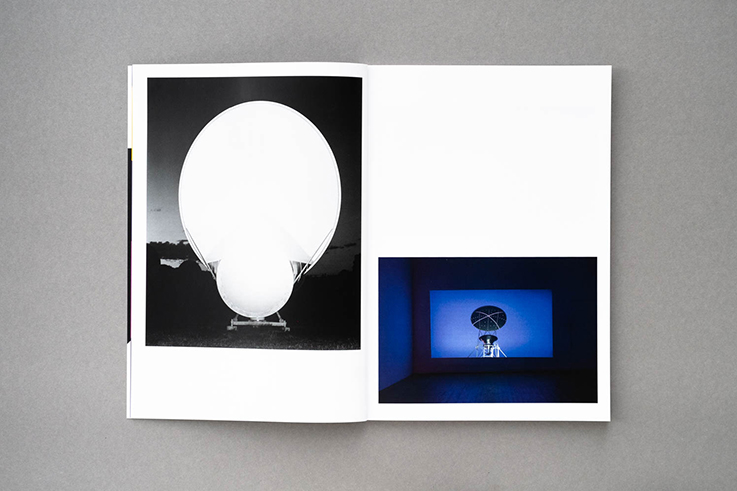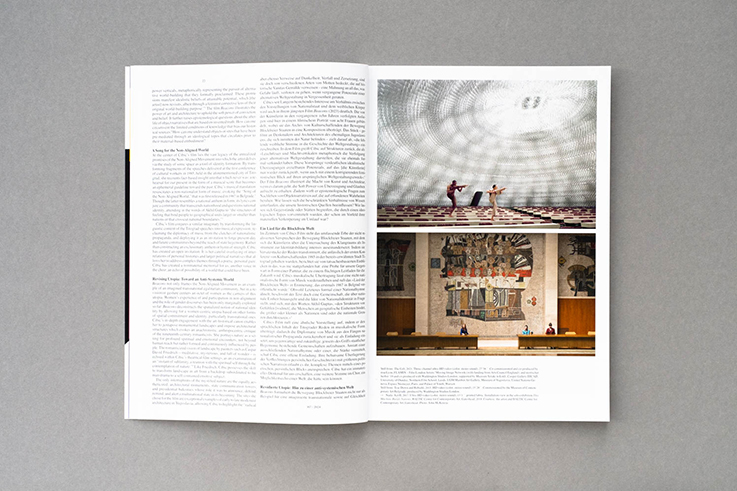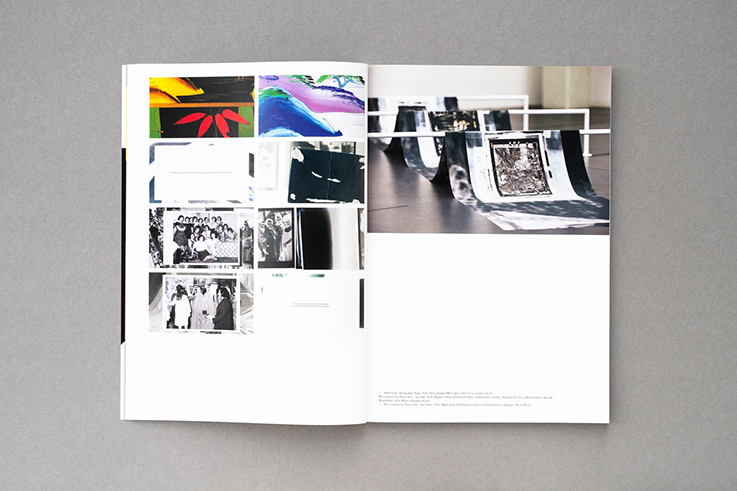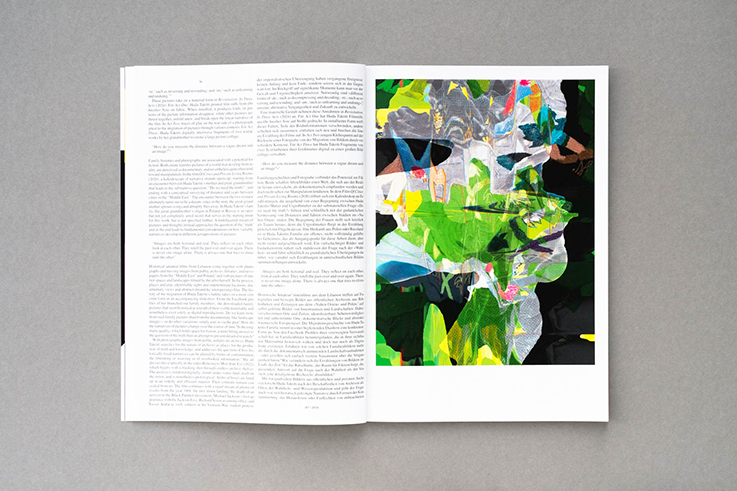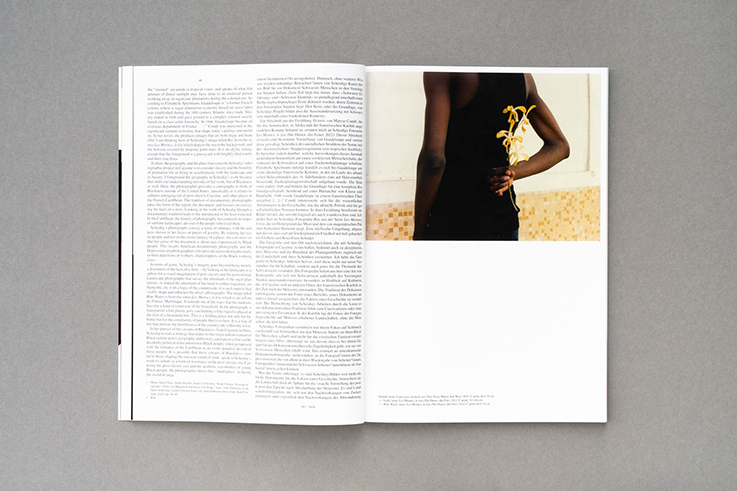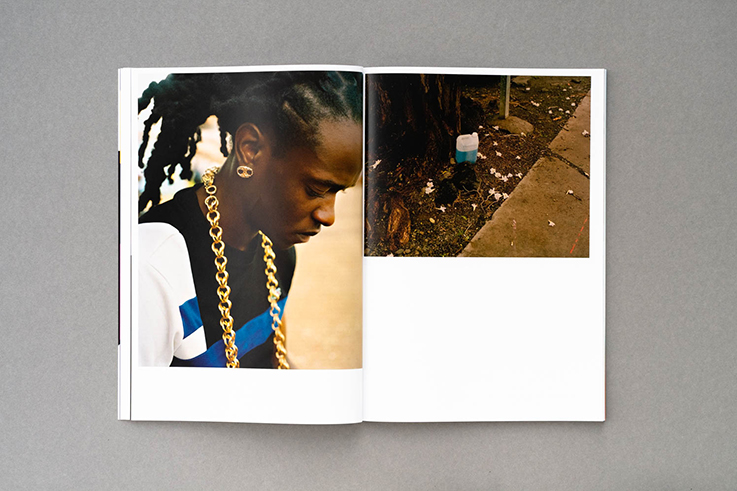Camera Austria International
167 | 2024
- LARA SCHOORL
We Are All Alone in the Dark: On Brittany Nelson’s Baroque Parallels - BRITTANY NELSON
- AMELI M. KLEIN
How Many Voices Does It Take to Form a Choir? Jasmina Cibic’s Anti-Systemic World-Making - JASMINA CIBIC
- CHRISTIN MÜLLER
“I will leave this for you to finish” - HUDA TAKRITI
- SERUBIRI MOSES
Circuits of Blackness - CÉDRINE SCHEIDIG
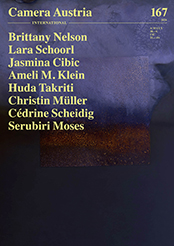
Preface
In her 2019 book Potential History: Unlearning Imperialism, Ariella Aïsha Azoulay uses the term in the main title to describe strategies that aim to subvert the established, usually Western historical narrative by employing counter-narratives and not-yet-considered perspectives, using them to enable a revised reading of the past. The artists presented in Camera Austria International No. 167 take a similar tack when they propose, through their works, alternative forms of reading and writing history, a new definition of the past from a present-day perspective, or even imagined, occasionally utopian futures that reach far beyond the capacity of human imagination. Related source material often involves photographs or codes anchored in visual culture, with the aim of highlighting the potential of not-yet-extant, revised, or imagined images.
Read more →Camera Austria International 167 | 2024
Preface
In her 2019 book Potential History: Unlearning Imperialism, Ariella Aïsha Azoulay uses the term in the main title to describe strategies that aim to subvert the established, usually Western historical narrative by employing counter-narratives and not-yet-considered perspectives, using them to enable a revised reading of the past. The artists presented in Camera Austria International No. 167 take a similar tack when they propose, through their works, alternative forms of reading and writing history, a new definition of the past from a present-day perspective, or even imagined, occasionally utopian futures that reach far beyond the capacity of human imagination. Related source material often involves photographs or codes anchored in visual culture, with the aim of highlighting the potential of not-yet-extant, revised, or imagined images.
Lara Schoorl takes Brittany Nelson’s video I Can’t Make You Love Me (2024) as a point of departure for investigating how various times are “folded” and read and mutually revised in her artistic work—making reference to Mieke Bal’s and Gilles Deleuze’s reflections on the Baroque fold. “In these works, past, present, and future coexist through material, concept, and content, without conflating these various tenses. Rather, together they find a way to distort linear time, and rewrite existing narratives.” In Nelson’s practice, this, not least, goes hand in hand with a space for possible parallels between human and nonhuman life.
Jasmina Cibic works not only with film and photography, but also repeatedly with sculpture, performance, and installation. She probes the construction of national identity/identities and also the symbolic demonstration of political power, examining the monopolizing of architecture and art, and the referencing of the same, especially in the context of former Yugoslavia. As Ameli Klein explores in her essay, Cibic confronts these mechanisms with feminist perspectives or with those based on soft power, as have rarely been of note in the “official” historical narrative: “By focusing her work on alternative modes of institution and world-building, Cibic highlights the potentiality of transnational solidarity and revisits the potential of art and culture as an active agent.”
Christin Müller homes in on the films, photographs, and installations by Huda Takriti created since 2020, which show how the artist bases her narratives on her own family history and their entanglements with the political situation in the “Middle East.” In these narratives, several strands unravel and are then rewoven, yet without any forms of the imparted story emerging as the “right” one. Müller notes how Takriti is ever intent on challenging interpretive sovereignty. The questions arise: “How do the narratives of pictures change over the course of time? Is the enigmatic quality, which holds space for fiction, a more fitting answer to the question of the truth than an attempt to present detailed research?”
Cédrine Scheidig focuses in her portraits, landscape photographs, and still lifes on the everyday life of Black people in French overseas territories, especially Guiana, Martinique, and Guadeloupe. She is particularly interested in questions pertaining to identity formation and belonging. As a starting point for interpreting Scheidig’s work, Serubiri Moses takes zouk—a musical style originating in Guiana and enjoying influences from the French Caribbean and Africa. He explains how the artist lends visibility and possible narratives to her own, Caribbean-influenced form of “Black experience.” She thus works to counteract established Caribbean visual narratives that focus on an exotic paradise oriented primarily to the landscape: “In her pursuit of the circuits of Blackness, from Cayenne to Paris, Scheidig reveals a strategy that relates to the origin and movement of Black culture across geography and history.”
Christina Töpfer, June Drevet
September 2024
Cover: Brittany Nelson, Blue, 2013. C-print, 152.4 × 127 cm. Courtesy: the artist.
Entries
Forum
Presented by the editors
Theresa Büchner
Sérgio Leitão
Louisa Boeszoermeny
Emile Rubino
Nina Porter
Sunny Pudert
Exhibitions
Avant-Garde and Liberation: Contemporary Art and Decolonial Modernism
mumok – Museum moderner Kunst Stiftung Ludwig Wien, Vienna, 7. 6. – 22. 9. 2024
CECILIA BIEN
This World Has to End
Cauleen Smith: The Deep West Assembly
Astrup Fearnley Museet, Oslo, 14. 6. – 15. 9. 2024
NINA STRAND
Elfriede-Mejchar-Preis für Fotografie 2024: Lisa Rastl
FLUSS, Schloss Wolkersdorf im Weinviertel, 16. 6. – 21. 7. 2024
MARGIT NEUHOLD
Ost-West-Verbindungen
Flucht in die Öffentlichkeit: 10. f/stop – Festival für Fotografie
Leipzig Verschiedene Orte, Leipzig, 31. 5. – 16. 6. 2024
MARIE MEYERDING
Franz Wanner: Mind the Memory Gap
Kindl – Zentrum für zeitgenössische Kunst, Berlin, 24. 3. – 14. 7. 2024
JULIA GWENDOLYN SCHNEIDER
Images in Relation: Practices of Post-Representational Aesthetics
MLZ Art Dep & Wiener Art Foundation, Trieste, 8. 6. – 6. 7. 2024
JUNE DREVET
The Poem Returns as an Echo: Dialogues with Theresa Hak Kyung Cha (1951–1982)
ISET—Contemporary Greek Art Institute at the National Gallery, Athens, 14. 6. – 31. 7. 2024
KYVELI MAVROKORDOPOULOU
A Letter to Lucia Moholy, July 2024
Lucia Moholy: Exposures
Kunsthalle Praha, Prague, 30. 5. – 28. 10. 2024
MARKÉTA OTHOVÁ
Über die Wirklichkeit hinaus
düsseldorf photo+. Biennale for Visual and Sonic Media
Verschiedene Orte, Düsseldorf, 17. 5. – 14. 7. 2024
CAROLIN FÖRSTER
Auch Technologie
Welt anschauen: Positionen aktueller Post-fotografie und digitaler Bildkultur
Kunstsammlungen am Theaterplatz, Chemnitz, 28. 7. – 27. 10. 2024
JOCHEN BECKER
Archiv Peter Piller: Transferfenster. Das Schalke Museum im Kunstmuseum Gelsenkirchen
Gelsenkirchen, 13. 6. – 4. 8. 2024
JENS BÜLSKÄMPER
Poesie des Alltäglichen. Fotografien von Elfriede Mejchar
Museum der Moderne Salzburg, Altstadt (Rupertinum), Salzburg, 26. 4. – 15. 9. 2024
Im Alleingang. Die Fotografin Elfriede Mejchar
Wien Museum musa, Wien, 18. 4. – 1. 9. 2024
Elfriede Mejchar: Grenzgängerin der Fotografie
Landesgalerie Niederösterreich, Krems, 13. 4. 2024 – 16. 2. 2025
ULRIKE MATZER
Michael Wesely: Berlin 1860–2023
Museum für Fotografie – Staatliche Museen zu Berlin, 12. 4. – 1. 9. 2024
STEFANIE DIEKMANN
Landschaft re-artikulieren
MMKK – Museum Moderner Kunst Kärnten, Klagenfurt, 13. 6. – 1. 9. 2024
CHRISTIAN EGGER
Ahlam Shibli: Dissonant Belonging
LUMA Westbau, Zürich, 7. 6. – 8. 9. 2024
LUMA Arles, 2. 7. 2023 – 7. 1. 2024
WOLFGANG BRÜCKLE
Photographic Land Surveys Arpenter, photographier la Nouvelle-Aquitaine
Frac Nouvelle-Aquitaine MÉCA, Bordeaux, 5. 4. – 6. 10. 2024
ARNO GISINGER
Books
Participant Observer Observed
Mercedes Vicente, Darcy Lange: Videography as Social Practice Palgrave
Macmillan, Cham 2023
JORGE RIBALTA
Joanna Zylinska, The Perception Machine: Our Photographic Future Between the Eye and AI
The MIT Press, Cambridge, MA; London 2023
TACO HIDDE BAKKER
Laura Bielau, TEST (2019–2021)
Spector Books, Leipzig 2024
EWA BORYSIEWICZ
Simon Baier, Markus Klammer (Hg.), Aesthetics of Equivalence. Art in Capitalism
August Verlag, Berlin 2023
PETER KUNITZKY
Gegen die ewige Wiederkehr des Gleichen
Vilém Flusser, Für eine Philosophie der Fotografie
REINHARD BRAUN
Imprint
Publisher: Verein CAMERA AUSTRIA. Labor für Fotografie und Theorie.
Owner: Verein CAMERA AUSTRIA. Labor für Fotografie und Theorie.
Lendkai 1, 8020 Graz, Österreich
Editors: June Drevet, Christina Töpfer (editor-in-chief).
Translations: Dawn Michelle d’Atri, Amy Klement, Soliman Lawrence, Vladimíra Šefranka Žáková, Alexandra Titze-Grabec.
English Proofreading: Dawn Michelle d’Atri.
Acknowledgments: Taco Hidde Bakker, Rebekka Bauer, Laura Bielau, Louisa Boeszoermeny, Theresa Büchner, Barbora Čápová, Jasmina Cibic, Ludger Derenthal, Regine Ehleiter, Philipp Goldbach, Leon Hösl, Gudrun Kemsa, Ameli M. Klein, Alex Simon Klug, Francesca Lazzarini, Sérgio Leitão, Kristina Lenz, Marco Lorenzetti, Falk Messerschmidt, Serubiri Moses, Christin Müller, Brittany Nelson, Markéta Othóva, Nina Porter, Sunny Pudert, Ljiljana Radlovic, Emile Rubino, Torsten Scheid, Cédrine Scheidig, Sabine Maria Schmidt, Lara Schoorl, Pola Sieverding, Magdalena Stöger, Huda Takriti, Sophie Tappeiner, Mercedes Vicente.
Copyright © 2024
No parts of this magazine may be reproduced without publisher’s permission.
Camera Austria International does not assume any responsibility for submitted texts and original materials. Although every effort has been made to find the copyright holders of all the illustrations used, this proved impossible in some cases. Interested parties are requested to contact the editors.

